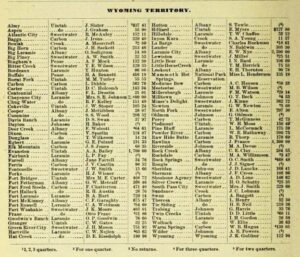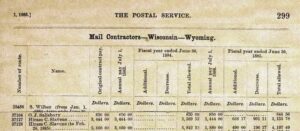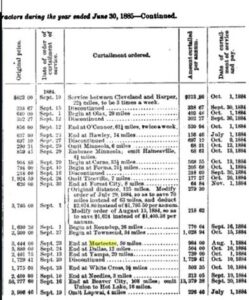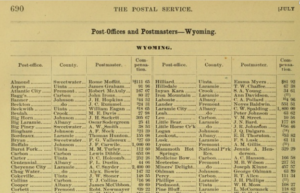Stage & Mail Service to Meeteetse
Part I: A Brief Look at Otto Franc and his Pitchfork Ranch
By Tom Davis
“Pitchfork Ranch History: The valley of the Greybull River in northwestern Wyoming has been the center of operations for the Pitchfork Ranch since 1878 when Count Otto Franc von Lichtenstein selected a location and built his first cabin establishing the second oldest ranch in the basin. Franc first came to the Big Horn Basin on a hunting trip in 1877-78 but kept his eyes open for a likely place to cattle ranch. His choice was well made, for the wide valley of the Upper Greybull was abundant with rich grass and good water. The river and stream bottom would provide shelter and the meadowland of the surrounding mountains could provide summer range for cattle. Even the winters in the upper valley were mild as a result of southwest winds and chinooks that often blew throughout the winter. The Pitchfork also provided a start for another western legend; Butch Cassidy stole his first horse from Otto Franc.” – the Pitchfork Ranch website
1882
On September 15, 1882, Otto Franc started the Big Horn Basin’s first United States Post Office on his Pitchfork ranch, which was located in the upper Grey Bull River Valley. At first, Josh Deane carried the mail to the Franc post office from Fort Washakie on a private mail route that he had started back in 1878.
The 1883 Official Register of the United States, reported as of July 1, 1883, the Franc post office had submitted receipts for “two-quarters,” and based on the amount of postage he had cancelled at his post office during those six months, Mr. Franc had earned a salary of $31.86.

Figure 1. The Official Register of the United States reported Franc salary. Find the image here.
1883 was a seminal year as far as the stagecoach service carrying the United States Mail and express packages from the Union Pacific railroad to the South Pass region, Lander and Ft. Washakie was concerned. During a terrible blizzard which had raged from January 31st through February 3rd that year, four people riding aboard stagecoaches running between South Pass City and Green River City were frozen to death. Two other men, a stage driver and the superintendent of the stage line had to have many frozen body parts amputated because of severe and life-threatening damage. Those two men had gone out ahead of the regular coach in a wagon to mark the road with willow branches, hoping that would enable the stage driver to keep to the road during the blinding blizzard.
The previous year, 1882, consideration had been given to starting a mail route from Rawlins to the Sweetwater Valley and Lander, but no final decision had been made. But shortly after that horrific blizzard, the U.S. Post Office Department decided to go ahead and open a new mail route between Rawlins and Lander. This new stage route from Rawlins, which at first ran only three times per week, would carry only part of the mail to what would become Fremont County in the spring of 1884. The daily stages running from Green River City would continue to carry all the mail for the South Pass region—and then would travel on to Fort Washakie—passing through Lander on the way to the military post.
Thus, in the spring of 1883, the Post Office Department let a three-year contract for the carrying of mail from Rawlins to Lander on Star Route #37128; the contract was set to begin on July 1, 1883. Hiram Slavens of Kansas City submitted the winning bid of $5880 (per annum) to carry the mail.

Figure 2. This document shows the wining bid for the mail route from Rawlins to Lander submitted by Hiram Slavens. Find the image here.
On January 22, 1883, the Post Office Department decided there was a sufficient volume of mail to warrant the opening of a star route between Fort Washakie and Franc, and accepted a bid from J. H. Warren to carry mail twice a week from Fort Washakie to Franc. This contact to carry mail to Franc, Wyoming was a short-term contract, lasting only from February 1st to June 30th, 1883.
Figure 3. Bid to carry mail from Fort Washakie to Franc.
Post Office Department records don’t show the subcontractors who were hired to carry the mail on star routes, but we know from other sources that Warren hired Josh Deane to carry the mail to and from Franc.
A short time later, on March 3rd of 1883, the Post Office Department let the three-year contract to carry mail from Fort Washakie to Franc (which was misspelled “Frank” on the contract), via Woodruff’s ranch, Baxter’s ranch, McDonald’s ranch to Franc and Carter. (I have never been able to find any evidence that the Carter post office shown on this contract was ever opened.)

Figure 4. Contract to carry mail from Fort Washakie to Carter and back by way of Franc. Found here.
Like J. H. Warren had done, Hiram Slavens, subcontracted star route #37127 to Josh Deane.
In March of 1883, Margaret B. Wilson filed an application asking that the “Franc post office” be moved to an unsurveyed location on Meeteetse Creek, where its name would be changed to “Meeteetse,” and Mrs. Wilson would serve as postmaster. According to Mrs. Wilson, mail would be delivered to the new post office only once a week from Fort Washakie, about 125 miles away, via Star Route #37127. (This is a bit of a mystery, since the mail contract for route #37127 required that mail on that route be carried twice each week.) It was stated on the application that the new post office would serve a “100 or more” patrons. Otto Franc co-signed the application (Figure 5).

Figure 5. Mrs. Margaret Wilson and Otto Franc co-sign the application for the post office to be moved to an unsurveyed location.
The new Meeteetse post office was located at the Wilson ranch on Meeteetse Creek, four miles above where it flowed into the Grey Bull River. The post office was officially opened on June 14, 1883.
Neither Otto Franc nor Mrs. Wilson drew a map on the page of the application where a hand drawn map was supposed to be included… just a small “x” was placed on the map. However, at the bottom of the page there is a legal description showing the location of the Franc post office. And it was stated that the area where the new post office would be located was 10 miles northeast of the Franc post office (Figure 6).
Figure 6. The post office would be 10 miles northeast of the Franc post office.
On August 1, 1884, fourteen months after the contract to carry mail between Fort Washakie and Carter had supposedly gone into effect, the Post Office Department officially “curtailed” route #37127 by 50 miles and belatedly ordered the mail carrier to end his route at the Meeteetse post office, rather than at “Carter” (Figure 7).
Figure 7. Route ended at the Meeteetse post office rather than Carter. Found here.
A closer look at the enlarged form below shows that when they officially shortened his route, the Post Office Department also curtailed the mail carrier’s pay by $964 per annum, and reduced his annual pay to $2480 per year.

Figure 8. Enlarged look at Figure 7 shows pay for the mail carrier of the Meeteetse route.
A letter to the editor published in the April 12, 1884, issue of the Billings Herald, reported that that Josh Deane had recently resigned as the mail carrier between Fort Washakie and Meeteetse, and that the new mail carriers were struggling to carry the mail over the Owl Creek mountains. (At that time, the “Billings Herald” simply called most places in the Grey Bull Valley, “Greybull.” The newspaper was one of the first to use the one-word form of that name. However, in 1884 that newspaper was still using the archaic spelling for the creek, “Mee-tee-tse.”)
Billings Herald
April 12, 1884
GREYBULL CORRESPONDENCE
“We have received no mail here lately as our mail carrier is three days behind his time and it is feared some mishap has befallen him. The probability is that he has lost the road in one of the snowstorms that are so numerous and frequent around Owl (Creek) Mountain, and wandered, God knows where, until he fell exhausted, to perish miserably from the cold–since he is a new man and is not very well acquainted with the roads. Our old friend Josh Deane recently resigned his post (as mail carrier) and settled down to ranching on the Wood River, where, according to his own account, he has the finest ranch in the country. Well, we wish him success, as a more punctual and obliging mail carrier we never had. Even the coldest weather last winter—and we had days when it was 40 and 45 degrees below zero—never caused Josh and his two Indian rats to miss a mail. If our mail (man) is not heard from in another day or two, a relief party will be sent out to find the cause of the delay.”
According to Tacetta B. Walker, author of “Stories of Early Days in Wyoming,” published in 1936:
“In 1884… (mail delivery to Franc and Meeteetse) was carried out with Jess Conway and Fred Whitney as drivers. Before the end of July, a subcontract scheduled to take effect on August 1, 1884, was made with Leonard Short and Finn McCoy, for $3,785 per annum, for four years.”
“Mr. Short had been a driver on the stage line from Green River to Lander and was familiar with the responsibility of getting the mail through whenever it was humanely possible to do so; and he and Mr. McCoy planned to be the carriers on this new line, being personally responsible for its successful operation. This history of the stage and mail line which ran through the western part of what is now Hot Springs County to Meeteetse, a short distance across the northern boundary of Hot Springs into what is now Park County, has been written by Mr. Short, who now (1936) lives in Thermopolis.”
…. “On taking over the contract, Short and McCoy bought the equipment owned by Jess Conway and Fred Whitney, the former stage drivers. Their equipment consisted of a small Studebaker wagon, two Indian pony teams, three saddle ponies, two pack ponies and two “outlaw” broncs that might be broken to carry packs, and a “dug-out” located on Muddy Creek at the foot of the Owl Creek Mountains. This stage station was soon known from Rawlins to Billings as the ‘Mail Camp.’”
(Josh Deane had established Mail Camp back when he first began carrying mail between Fort Washakie and Meeteetse.)
“Mr. Short, using a team and buckboard, brought the mail from Fort Washakie on Monday, staying that night at the mail camp, which was his home. On Tuesday, with a saddle horse and pack animals, he climbed over the Owl Creek Mountains, placing the mail for the settlers on Owl Creek in a large box near the crossing of the main branch of the creek.” ….
“At the Wilson place on Cottonwood, reached about noon, Short would meet McCoy coming from the north, having left Meeteetse Creek on Monday morning, staying overnight at the Dickinson-McDonald ranch on Gooseberry, then riding over the Grass Creek divide, reaching Cottonwood at dinner-time Tuesday. Here the riders exchanged mail sacks, and while eating a good meal of beans and bacon with sour-dough bread, all cooked in a Dutch-oven and washing it down with black coffee, they told each other the news from their ends of the route; then mounting their tired cayuses they slowly retraced the ride of the forenoon. The next day, after spending the night at the Mail Camp, Short hitched up a team of half-broken ponies to the Studebaker wagon and drove to Fort Washakie to complete the circuit. Meanwhile, on the third day of his journey, McCoy left Gooseberry and rode to Meeteetse Creek” (which was the end of the route. This pattern was repeated twice each week.)
Ms. Walker gave us many other fascinating details about carrying the mail from Fort Washakie to Meeteetse during 1884 and 1885. Describing the road, she wrote:
“The road from the Wind River Valley to the Greybull Valley was a natural game trail, traveled first by Indians and later by prospectors and settlers. There were no bridges over the streams, and any improvement made was only temporary, being done at times of emergency by the stage drivers or settlers in order to pass over with their loaded wagons. The Big Wind River was usually fordable, except during the season of high water, which usually lasted about three months. Many risks were taken at that time in crossing swollen mountain streams, and many accidents occurred. W. A. Spooner, while helping to drive a herd of cattle across the Wind River at Old Merritt Crossing, was drowned. Nearly every year the river claimed victims from among those who dared to attempt a crossing when the melting snows had raised the stream to a dangerous point. After the building of a ferry by Mr. J. D. Woodruff, the first ferry to be operated on Wind River, the travelers could safely cross during early summer months. This ferry was near Old Merritt’s Crossing. Woodruff was a sheepman, and built shearing pens nearby. The wool sheared there was hauled to Rawlins by J. K. Moore’s string teams.”
“Between Wind River and the Owl Creek Mountains, the road crossed many streams near their source, so the lack of bridges was usually not a serious matter. There were no settlers close, but a mail camp had been established on Muddy Creek at the foot of the mountain. The climb up the southern side of the mountains was difficult. The first fall after the opening of this route in 1884, the mail contractors hired help to build a wagon road to the summit. After several weeks of strenuous labor moving rocks and building dug-ways, a passable wagon road with many hairpin turns was built to the top.”
“The northern slope was less precipitous, consisting of open parks, timber, and only short steep inclines in between. At the foot of the mountain was George Pardee’s ranch located on the south fork of Owl Creek. The crossing of the north fork of this creek was a short distance north, and about six miles east of Pardee’s. At that crossing was the ranch of George Smith. From Owl Creek the road led in a general northwest direction up Twenty-one Creek, then over the divide at the head of Prospect Creek to the head of Little Grass Creek. Then the stage road went down that creek past its confluence with the main Grass Creek to the LU Ranch. That ranch was established in the early ‘80’s by George Baxter, later governor of the state; from the LU over the ridge to the northwest to Enos Creek, at the mouth of which was the Quarter-Circle Y ranch on Gooseberry, owned by Angus McDonald. From the Quarter-Circle Y, the road wound up the creek for five or six miles, and then passed over the divide to the head of Iron Creek. It continues down Iron Creek to and across the Greybull River to Meeteetse Creek, on which was the Franc post office. That post office, operated by Mrs. Andrew Wilson, was the end of the line. Mr. Wilson, with his wife and daughters, had moved from Ohio in 1881. These were the first white women to make their home in the Big Horn Basin.”
A brief biography of Tacetta B. Walker can be found in Annals of Wyoming, Volume 251, No. 1, January 1953 (Figure 9).

Figure 9. Biography of Tacetta B. Walker in the Annals of Wyoming.
A brief look at the Fort Washakie-Meeteetse Mail Route in 1885
We know that in early March of 1885, Leonard Short and Finn McCoy were still the sub-contractors on mail route #37127.
Carbon County Journal
March 7, 1885
Lander Locals
“Leonard Short and Fin McCoy, sub-contractors of the Mee-tee-tse mail line were in Lander today.”
Some years later, this brief biography of Leonard Short appeared in Lander’s Fremont Clipper:
Leonard Short Biography 1893
Fremont Clipper
December 29, 1893
“Mr. Leonard Short, the enterprising proprietor of the Cottage Home Hotel, is an old-timer in the West, having come to Colorado when quite young. For a long time, he ran a stage line in that country. Mr. Short came to Fremont County about ten years ago and took the contract from the United States Government of carrying mail from Fort Washakie to Meeteetse, making connection there with a mail line from Montana.
“A couple of years ago he located in Lander where he has successfully engaged in the hotel and livery business ever since. Mr. Short is an enterprising businessman….”
Carbon County Journal
June 27, 1885
“Lander: Mr. P.P. Dickenson is daily expected in from his Gooseberry cattle ranch. Mr. George Wise, Mr. Chas. Wise and Col W.D. Pickett have been in from Gray Bull and Meeteetse, proving up on their land claims. Mr. Richard Ashworth, of Gray Bull, passed through here on his way to Cheyenne. He just recently received the cattle herd of Mr. Geo. Wise that he purchased in early spring. Consideration was, $32 per head, aggregating $10,000.”
Franc to be Sauer Kraut King
“Mr. Otto Franc, the great German cattleman of Gray Bull, has inaugurated a new enterprise of Fatherland thrift. He has found the extensive bottoms of his large holdings on the Gray Bull particularly adapted to raising cabbage. He planted largely this spring and has just received a consignment of a dozen Mynheers and their fraus (Editor Friend’s attempt to write in pigeon German) from his native Dutch lowlands, to care for the growing crop…. Necessary buildings are being put up on the ranch; a large shipment of barrels and kegs are on the way via Billings, and every preparation for the manufacture of sauer kraut on an extensive scale is being made.”
“The manufactured article will be floated by the means of rafts down the Gray Bull to the Big Horn, and follow the Big Horn to the Yellowstone River. From that point they will be hauled to a convenient point on the Northern Pacific, and shipped east. The work is under the immediate supervision of Mr. John B. Gleaver, former cattle foreman for Mr. Franc. (Mr. Gleaver) brings to his duties a weight of experience and appreciation that cannot fail to ensure success.”
The 1885 Official Register of the United States reported that during the last fiscal year, which ended June 30, 1885, Postmaster M. B. Wilson at Meeteetse had earned $217. 51 during the past 12 months. At the bottom of the left column, we see that northern Fremont County had a second post office at the end of that fiscal year. It was located at Corbett on the Stinking Water River. Robert Newmayer, the postmaster at Corbett, had earned $39.22 cancelling postage during the six months that that post office had been opened.

Figure 10. 1885 Official Register of the United States found here.
Carbon County Journal
December 12, 1885
Lander News
“The stages are regular, and often come in very early now. We hope that this new line (from Rawlins) will be able to demonstrate this winter, by sheer facts, which of the two routes, this from Rawlins or the Green River one, is the most reliable route. Facts are stubborn things, but let us have the facts.”
About the Author
Tom Davis, a long time resident of the Greybull area and member of the Big Horn County Historical Society, moved to Cody a few years ago after selling the family farm where his grandparents had homesteaded in 1908.
Resources
Stay tuned for the next installments in Tom Davis’ series on early mail service in the Bighorn Basin and Meeteetse. As those are published, we will update these notes to reflect subsequent posts!
Listen to Season 3, Episode 3 on early stage and mail routes in Meeteetse and the West. In this episode, we explore the industry of transportation and its role in the success of Meeteetse. Tom Davis of Cody was generous to provide much of the research about the early mail and stage routes in the area. We also speak to Michael R. Grauer, McCasland Chair of Cowboy Culture and Curator of Cowboy Collections and Western Art and Cheryl Mullenbach, author of Stagecoach Women.

